Human primordial germ cell commitment in vitroassociates with a unique PRDM14 expression profile
Fumihiro Sugawa, Marcos J Araúzo‐Bravo, Juyong Yoon, Kee‐Pyo Kim, Shinya Aramaki, Guangming Wu, Martin Stehling, Olympia E. Psathaki, Karin Hübner, Hans R. Schöler, 06.03.2015
Abstract
Primordial germ cells (PGCs) develop only into sperm and oocytes in vivo. The molecular mechanisms underlying human PGC specification are poorly understood due to inaccessibility of cell materials and lack of in vitro models for tracking the earliest stages of germ cell development. Here, we describe a defined and stepwise differentiation system for inducing pre‐migratory PGC‐like cells (PGCLCs) from human pluripotent stem cells (PSCs). In response to cytokines, PSCs differentiate first into a heterogeneous mesoderm‐like cell population and then into PGCLCs, which exhibit minimal PRDM14 expression. PGC specification in humans is similar to the murine process, with the sequential activation of mesodermal and PGC genes, and the suppression of neural induction and of de novo DNA methylation, suggesting that human PGC formation is induced via epigenesis, the process of germ cell specification via inductive signals from surrounding somatic cells. This study demonstrates that PGC commitment in humans shares key features with that of the mouse, but also highlights key differences, including transcriptional regulation during the early stage of human PGC development (3–6 weeks). A more comprehensive understanding of human germ cell development may lead to methodology for successfully generating PSC‐derived gametes for reproductive medicine.
SUGAWA, Fumihiro, et al. Human primordial germ cell commitment in vitro associates with a unique PRDM14 expression profile. The EMBO journal, 2015, 34. Jg., Nr. 8, S. 1009-1024.
Publication: https://doi.org/10.15252/embj.201488049
 Disclaimer
Disclaimer
The publication Human primordial germ cell commitment in vitroassociates with a unique PRDM14 expression profile by Fumihiro Sugawa, Marcos J Araúzo‐Bravo, Juyong Yoon, Kee‐Pyo Kim, Shinya Aramaki, Guangming Wu, Martin Stehling, Olympia E. Psathaki, Karin Hübner, Hans R. Schöler is published under an open access no derivatives license: : https://creativecommons.org/licenses/by-nc-nd/4.0. Permits non-commercial use, distribution and reproduction in any medium, without alteration, provided the original work is properly cited and it is reproduced verbatim. Thus, tables can not be shown in MFGA format.
Curation by the MFGA team Relevant data sets presented in the publication have been identified. If possible, annotations (title, general information, conditions, processed tissue types and processed cell types) have been added based on information from the publication. Data tables and images that provide a good overview on the publication's findings on the data set have been extracted from the publication and/or supplement. If not stated otherwise, images are depicted with title and description exactly as in the publication. Tables have been adjusted to the MFGA table format. Conducted adjustments are explained in the detailed view of the tables. However, titles and descriptions have been adopted from the publication.
Data set 1: Mesoderm-committed PGC-precursor formation from human PSCs and further differentiation towards PGCLC
Transcriptome: Microarray
Species
| Species |
|---|
| Human |
Cell Types
| Cell ontology | Maturity | Description | Species | Replicates | Cells per replicate |
|---|---|---|---|---|---|
| CL_0002322: embryonic stem cell | Embryonic | Embryonic stem cell lines (H9 and HuES6) | Human | 1 | |
| CL_0002248: pluripotent stem cell | Induced pluripotent stem cell lines (393.2 and SA8/25) | Human | 1 | ||
| Primordial | Primordial Germ cell like cells derived from d2-precursors | Human | 2 | ||
| CL_0000670: primordial germ cell | Mesoderm-committed PGC precursors; OCT4+/BLIMP1+ PGC precursors/ d2 Human induced Pluripotent Stem Cells | Human | 2 |
Images

Figure 1 A and B: Induction of OCT4+/BLIMP1+ PGC precursors from human iPSCs
A: Effects of ActA and BMP4 on the expression of selected pluripotency, PGC, and mesodermal genes during PGC-precursor induction. DM: dorsomorphin, SB: SB431542. Samples were calibrated with iPSC values, and iPSC values depict 1. Y-axes are in log2 scale. </br>B: Gene expression dynamics of selected pluripotency, PGC, and mesodermal genes during prolonged PGC-precursor induction of up to day 7. Y-axes are in log2 scale.
Licensed under: https://creativecommons.org/licenses/by-nc-nd/4.0

Figure 2 A: Induction of PGCLCs from human iPSCs
Schematic presentation of PGC-precursor and PGCLC induction.
Licensed under: https://creativecommons.org/licenses/by-nc-nd/4.0

Figure 2 D: Induction of PGCLCs from human iPSCs
Gene expression analysis of selected PGC markers in TRA-1-81+/cKIT+ and SSEA1+/cKIT+ FACS fractions of d4 PGCLCs. Samples were calibrated with iPSC values, and iPSC values depict 1.
Licensed under: https://creativecommons.org/licenses/by-nc-nd/4.0
Data set 2: PGCLC characterization shows global progress of epigenetic reprogramming similar to in vivo PGCs
Methylome: Targeted Deep Bisulfite Sequencing
Species
| Species |
|---|
| Human |
Cell Types
| Cell ontology | Maturity | Description | Species | Replicates | Cells per replicate |
|---|---|---|---|---|---|
| CL_0002322: embryonic stem cell | Embryonic | Embryonic stem cell lines H9 and HuES6 | Human | 1 | |
| CL_0002248: pluripotent stem cell | Induced pluripotent stem cell lines (393.2 and SA8/25) | Human | 1 | ||
| Primordial | Human | 3 |
Images
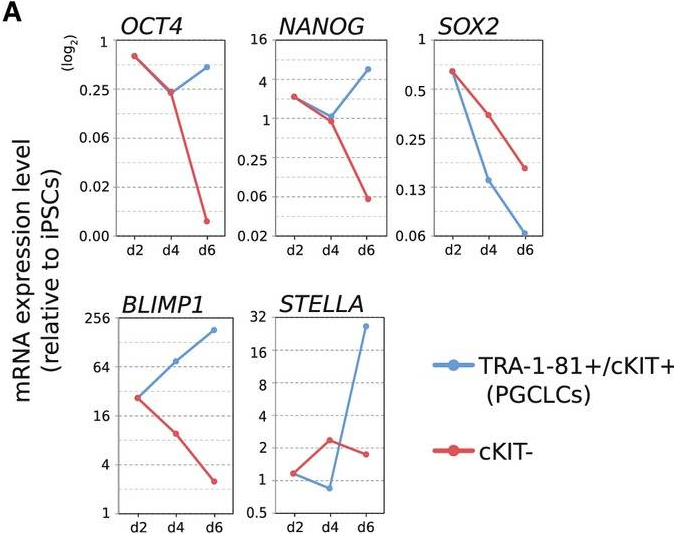
Figure 3 A: Characterization of PGCLCs
Gene expression dynamics of selected pluripotency and PGC genes in FACS-sorted, specified cells during PGC induction. The value for iPSCs is set as 1, and values are on log2 scale
Licensed under: https://creativecommons.org/licenses/by-nc-nd/4.0
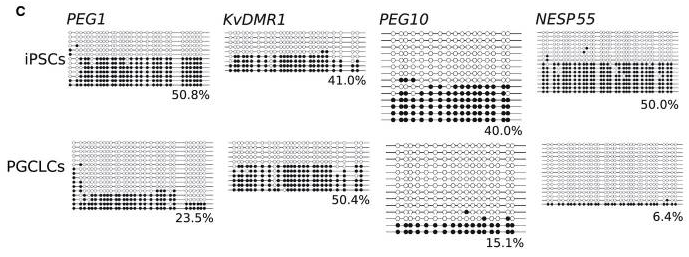
Figure 3 C: Characterization of PGCLCs
Bisulfite sequence analysis of DMRs of the imprinted genes (PEG1, KvDMR1, PEG10, and NESP55) in iPSCs (top) and d6 TRA-1-81+/cKIT+ PGCLCs (bottom). White and black circles represent unmethylated and methylated CpG sequences, respectively.
Licensed under: https://creativecommons.org/licenses/by-nc-nd/4.0
Data set 3: OCT4+/BLIMP1+ PGC precursors contribute to the subsequent generation of PGCLCs with similar gene expression compared to mice
Transcriptome: Microarray
Species
| Species |
|---|
| Human |
| Mouse |
Cell Types
| Cell ontology | Maturity | Description | Species | Replicates | Cells per replicate |
|---|---|---|---|---|---|
| CL_0002322: embryonic stem cell | Embryonic | embryonic stem cell lines H9 and HuES6 | Human | 1 | |
| CL_0002248: pluripotent stem cell | induced pluripotent stem cell line | Human | 1 | ||
| Primordial | Primordial germ cell like cells | Human | 3 |
Images
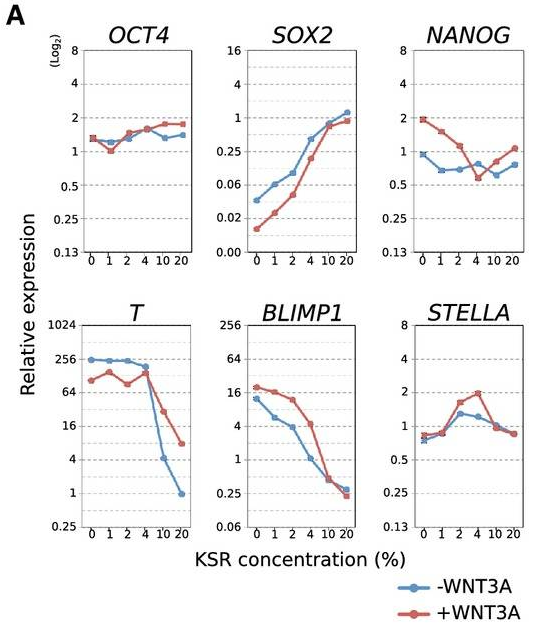
Figure 4 A: Effects of KSR and WNT3A on PGC-precursor and PGCLC induction
Effects of KSR and WNT3A during PGC-precursor induction on the expression of selected pluripotency, PGC, and a mesodermal gene of d2 cultures. The value for iPSCs is set as 1, and values are on log2 scale. Data are presented as means ± SD (n = 3).
Licensed under: https://creativecommons.org/licenses/by-nc-nd/4.0
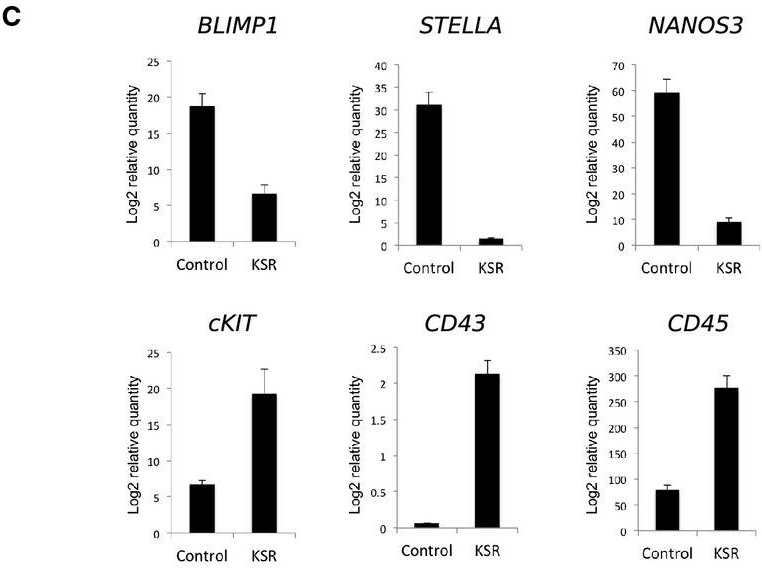
Figure 4 C: Effects of KSR and WNT3A on PGC-precursor and PGCLC induction
Gene expression analysis of selected PGC and hematopoietic markers in d6 PGCLCs that were cultured in 0% (control) or 20% KSR (KSR) condition during PGC-precursor induction. Samples were calibrated with iPSC values, and iPSC values depict 1. Data are presented as means ± SD (n = 3).
Licensed under: https://creativecommons.org/licenses/by-nc-nd/4.0
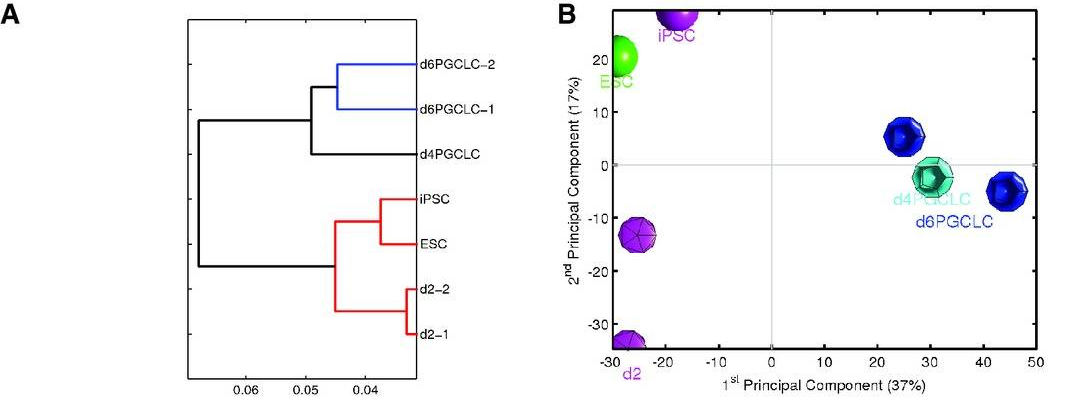
Figure 5 A and B: Transcriptomics profiles during PGC-precursor and PGCLC induction
A: Unsupervised hierarchical clustering of HuES6 ESCs, 383.2 iPSCs, d2 PGC-precursor cultures, and FACS-sorted PGCLCs. </br>B:Principal component analysis of HuES6 ESCs, 393.2 iPSCs, d2 PGC-precursor cultures, and FACS-sorted PGCLCs.
Licensed under: https://creativecommons.org/licenses/by-nc-nd/4.0

Figure 5 D: Transcriptomics profiles during PGC-precursor and PGCLC induction
Venn diagrams of the transcriptomics meta‐analysis with the intersections of the DEGs of mouse in vitro PGCLCs, human in vivo PGCs, and human in vitro PGC‐like cells in relation to their respective pluripotent counterparts in their respective platforms.
Licensed under: https://creativecommons.org/licenses/by-nc-nd/4.0
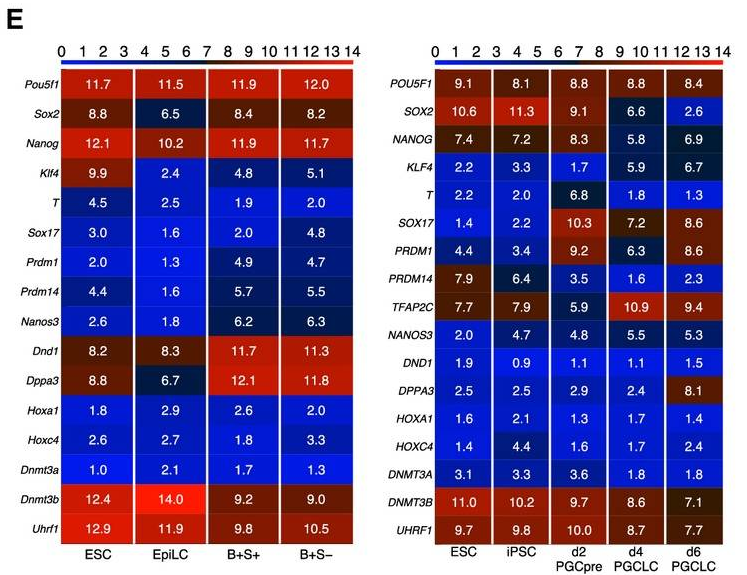
Figure 5 E: Heatmap of pluripotent, germ cell, mesodermal, and chromatin-related markers in mouse (left) and human (right) transcriptomics samples
(Tfap2c is not targeted in the Illumina MouseRef-8 v2). The color bars codify the gene expression in log2 scale. Red corresponds to high gene expression. Blimp1+/Stella+ PGCLCs are denoted “B+S+”, and Blimp1+/Stella− PGCLCs are denoted “B+S−”.
Licensed under: https://creativecommons.org/licenses/by-nc-nd/4.0
Data set 4: Transcriptomics analysis suggests that mouse Prdm14-regulated genes are controlled by different mechanisms in human and mouse PGCs
Transcriptome: Microarray
Species
| Species |
|---|
| Human |
| Mouse |
Cell Types
| Cell ontology | Maturity | Description | Species | Replicates | Cells per replicate |
|---|---|---|---|---|---|
| CL_0002248: pluripotent stem cell | d2 Human induced pluripotent stem cells; Mesoderm-commited PGC precursors | Human | 2 | ||
| Primordial | Day 4 human induced Pluripotent Stem Cells (PGCLC) | Human | 1 | ||
| Primordial | Day 6 human induced Pluripotent Stem Cells (PGCLC) | Human | 2 |
Images
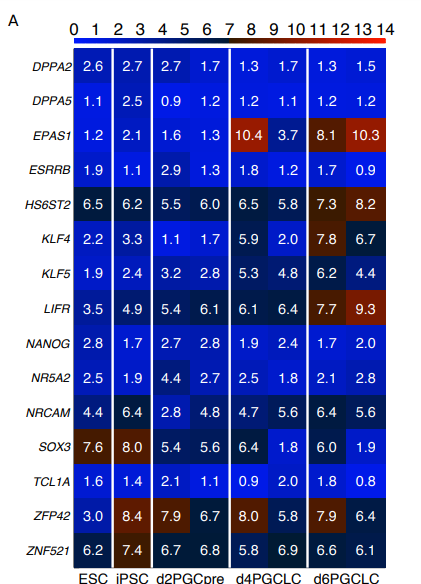
Figure S8 A:
MFGA curated description: Heatmap of the transcriptomics pattern of PRDM14-regulated-genes. The colorbars codify the gene expression in log2 scale. Red corresponds to high gene expression.
Licensed under: https://creativecommons.org/licenses/by-nc-nd/4.0
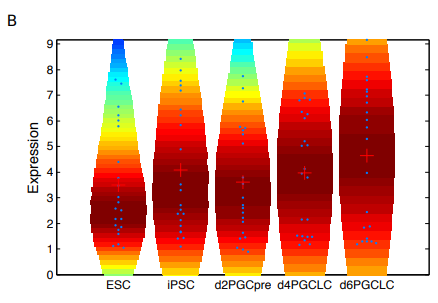
Figure S8 B:
MFGA curated description: Violin plots of the expression distribution of the PRDM14-regulated genes. The red squares represent the position of the means. The blue points represent the spread of the expression of the genes used to build the distributions.
Licensed under: https://creativecommons.org/licenses/by-nc-nd/4.0
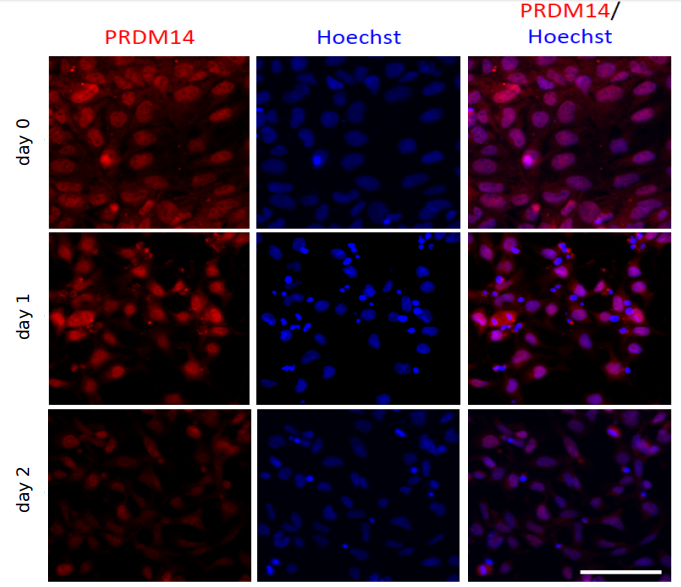
Figure S11:
MFGA curated description: Immunocytochemical staining of PRDM14 in precursor cultures. Immunofluorescence analysis for PRDM14 (red) on days 0, 1, and 2 of germ cell–precursor induction. Nuclei were stained with Hoechst (blue). Scale bar: 100 μm.
Licensed under: https://creativecommons.org/licenses/by-nc-nd/4.0
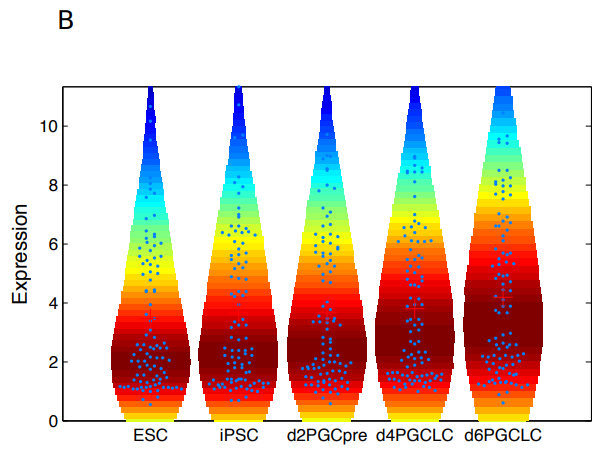
Figure S5 B:
MFGA curated description: Violin plots of the expression distribution of the core PGC genes. Changes during human PGCLC induction. The red squares represent the position of the means. The blue points represent the spread of the expression of the genes used to build the distributions.
Licensed under: https://creativecommons.org/licenses/by-nc-nd/4.0
